Crisis Response Journal edition 12:2 - Out now!
The current issue of CRJ is now available to subscribers in hard copy and online.
Here's a quick look at what's inside. This issue, we present incident reports on the earthquakes in Italy and examine how private and public organisations - including fire services - worked together on mass evacuations during the wildfire at Fort McMurray. We also focus on crisis management, covering workplace preparedness, and case studies of a food recall crisis and a large cyber attack.
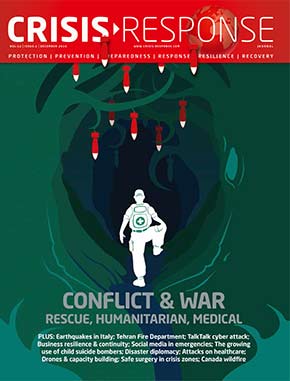
Terrorism and security are examined, with articles on contingency planning for firearms attacks in public places, as well as a look at organisational security in the face of terrorism and a report on the disturbing trend of children being used in terrorist attacks.
Our main features are on conflict and humanitarian response, and attacks on healthcare.
The technology section examines new developments in tracking epidemics, safer surgery innovations in crisis zones, the role of information technology within the United Nations' Sustainable Development Goals, and an introduction to WeRobotics, a not for profit that helps local communities in developing countries to harness the power of robots.
To get the latest in news, thought leadership, research and case studies across the whole gamut of crisis and emergency preparedness, resilience, prevention and response, subscribe now by clicking here
Take a look at what is coming up:
How can the next Secretary of Homeland Security succeed?
With the US presidential election over and Donald Trump waiting to take over the Oval Office, Rich Cooper opines that Homeland Security is by far the most complex, challenging and interdependent of all the cabinet positions. Here, he outlines some thoughts on how the next Secretary of the DHS can succeed in what will continue to be a dynamic, risk-filled environment.
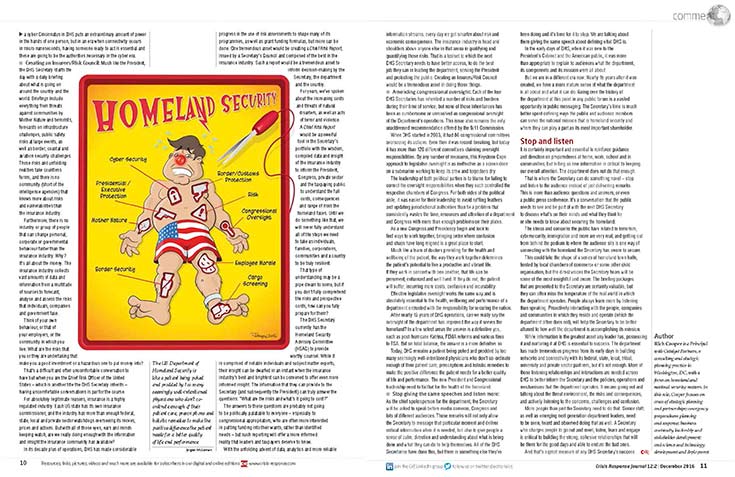
Wildfire evacuations in Fort McMurray
CRJ takes a look at how public and private forces combined to work together when Canada’s most costly environmental disaster threatened lives, communities and industry.
Italian earthquakes
Several destructive earthquakes have rocked Italy, starting with one that struck on August 24, which killed 298 people. The Italian Civil Protection Department reports on the immediate response, as well as ongoing relief efforts to provide emergency accommodation, salvage important cultural heritage and ensure continuity for affected residents.
Utilising all resources in oil spill response
CRJ 11:4 outlined Finnish recognition of the role of volunteers in oil spill response, particularly in the environmentally sensitive, but busy shipping area of the Gulf of Bothnia. Reita Waara describes how an exercise incorporating volunteer agencies unfolded.
Tehran Fire Department profile
Navid Bayat describes the growth and development of the Tehran Fire Department, saying that international collaboration and advice are essential to creating a safer community.
Resilience and emergency management
Workplace disaster preparedness
Could making emergency preparedness kits compulsory for all workplaces reduce the burden on emergency services? Christoph Schroth investigates.
Struggling to manage a food recall crisis
Tony Jaques examines how a company at the centre of a food recall crisis in Australia found itself fatally entangled in a quagmire of public panic and political opportunism.
The TalkTalk cyber attack
On October 21, 2015, UK telecoms company TalkTalk suffered a serious and sustained cyber attack. Jessica Lennard describes the lessons learned and says that it should be mandatory for all businesses to report serious cyber breaches, both to the regulator and to their customers.
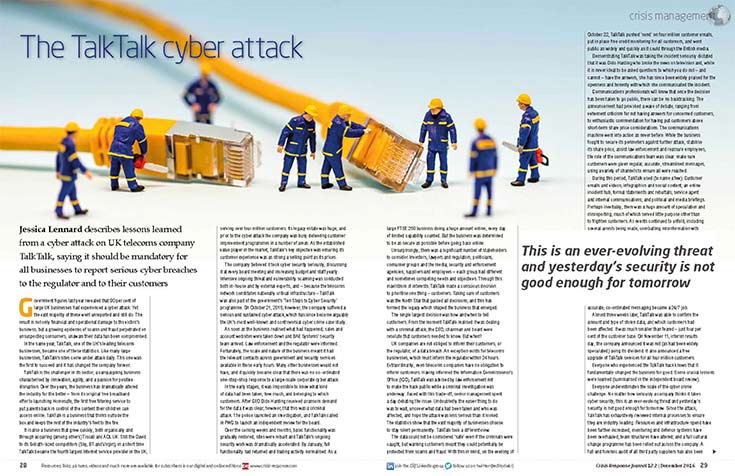
Social media: The new frontier
Ludovic Blay and Dr Patrick Lagadec write about how a volunteer virtual operation support team network in France is helping the authorities to embrace social media for emergency management.
Countering false rumours online
To help counter the spread of false information during a crisis, authorities need to build trusted online relationships with the public, according to Nicolas Vanderbiest.
The vital role of critical communications platforms
Organisations are looking beyond proactively rehearsing for crisis to being in a constant state of readiness that could affect business or operational performance. Nick Hawkins of Everbridge describes how investing in communications technology can improve emergency responses.
Managing cascading effects
Olivia Soave and Martin de Maupeou describe a European project that has been developing decision support tools to help crisis managers address cascading effects in a crisis.
Terrorism and security
The widening scope of security risk
To support the emergency services, all organisations need to become more sophisticated in the way in which they organise their security, including preparing for, responding to, and recovering from terrorist incidents, according to Roger Gomm.
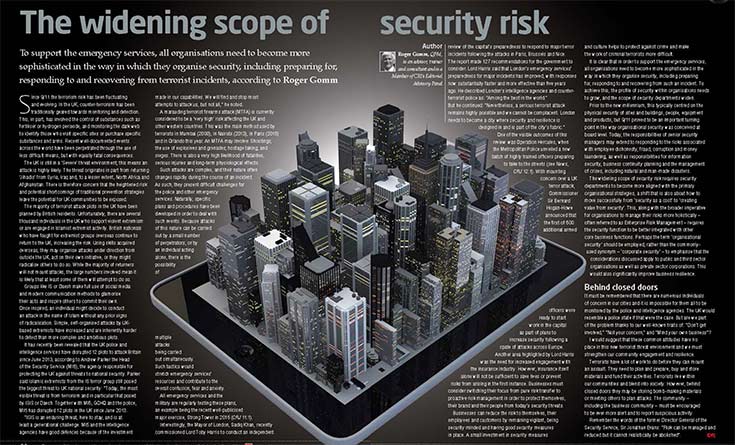
The growing use of children in terrorism
Lina Kolesnikova highlights the disturbing trend of young people being radicalised, exploited, coerced, groomed and forced to take part in terrorist activities, or used as suicide bombers.
Conflict and war
Disaster diplomacy: Why don’t disasters cause peace?
It appears that disasters and crisis response remain low on the list of priorities when seeking lasting reconciliation with an enemy, says Ilan Kelman. Neither disaster, nor diplomacy, are simple to navigate, making disaster diplomacy particularly complex.
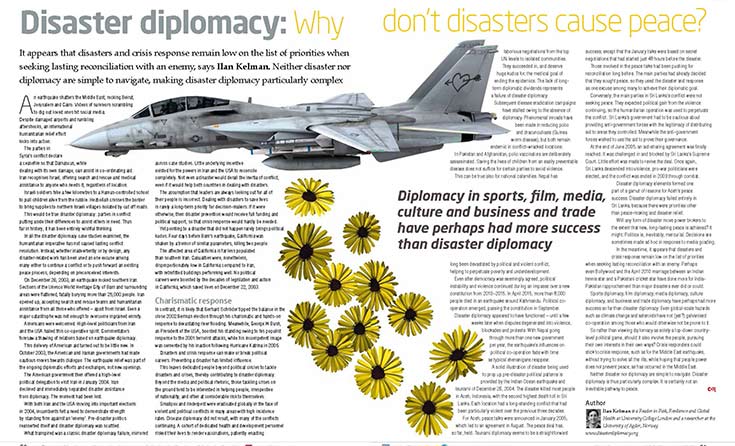
The impact of IEDs on aid
The use of improvised explosive devices have consequences on the delivery of humanitarian aid that go far beyond the shock of the initial explosion, according to Christina Wille. As well as the tragic results for the people involved, their families and beneficiaries, IEDs also limit the delivery of humanitarian aid.
IEDs: Global solutions for a global threat
International political will must shift dramatically if we are to tackle the scourge of improvised explosive devices, says Member of Parliament Dr Matthew Offord, who is the new chairman of the All Party Parliamentary Working Group (APPG) on Explosive Devices in the UK. The CRJ is pleased to support this APPG and is a member of its expert advisory group.
Civil defence in times of conflict
James Le Mesurier outlines how the work of Syria’s volunteer civil defence tams has evolved from providing trauma care on scene and responding to rocket attacks, to spanning the entire spectrum of prevention, protection, response and recovery.
Crisis response and peace operations in Africa
Understanding the emerging African Peace Operations Model, where it came from, how it works and future challenges, is crucial for humanitarian and emergency response communities, say Cedric de Coning, Linnéa Gelot and John Karlsrud.
Attacks on healthcare
Safeguarding healthcare in armed conflict zones
Ali Naraghi, Head of the ICRC’s Healthcare in Danger initiative, introduces CRJ’s feature on violence against healthcare with an overview of the situation and what needs to be done to ensure that such violence does not become the new norm.
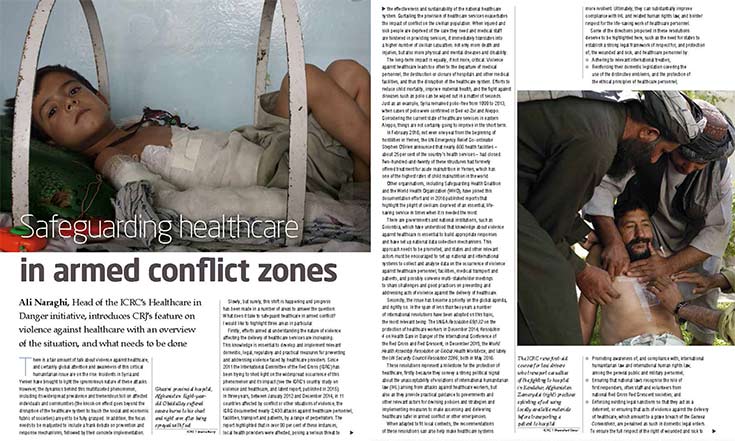
Protecting the protectors
Casey Brunelle outlines the urgent need for practical solutions to improve the safety and security of healthcare workers deployed in the field.
World Health Organization priorities for addressing attacks
Meeting life-saving health needs in humanitarian settings is increasingly challenging. And in the current global context, these needs are unprecedented, contends Erin Kenney.
Medical transport under fire
Hospitals and healthcare facilities in conflict zones regularly experience acts of violence, but medical transport in many other countries also comes under attack. Chaim Rafalowski, Dr Romeo Paredes and Agnieszka Cholewinska describe some counterstrategies, drawing upon experience in El Salvador and Israel.
Technology
Tracking epidemics through genome sequencing
Why is genome sequencing so important in epidemic outbreaks? How can new portable genome sequencing technology developments help in remote and developing areas? Emily Koehler, Ian Bogdanowicz, Carly Esteves and Dr Ian Portelli answer these questions.
Firefighting, cancer and personal protective equipment
The potential link between firefighting and cancer is putting the spotlight on the cleaning and maintenance of PPE, writes David Matthews
Keeping blood and vaccines safe
Emily Hough speaks to Luc Provost, CEO of cold chain and blood storage transport company, B Medical Systems, about innovations to improve healthcare in regions of the world that experience limited power supplies.
CRJ R&D: Safe surgery innovation in crisis
New Technologies have been designed to combat the ubiquitous inaccessibility of safe surgery, which is a major global health issue, especially in resource-poor areas prone to disaster, write Sarah Ayton, Carly Esteves and Dr Ian Portelli. Meanwhile, Seth Goldstein of Mobilize Rescue also looks at medical first aid kit developments designed to help untrained ‘immediate responders’ to intervene in a medical emergency.
The role of information technology in the UN’s Sustainable Development Goals
Alina O’Keeffe describes some of the new technology being developed for humanitarian applications, especially for internally displaced persons and refugees, which was presented at the Aid and International Development Forum earlier this year.
Social automation, local humanitarians and the future of crisis response
Dr Andrew Schroeder introduces this new series on WeRobotics, a global non-profit initiative that aims helps local communities in developing countries harness the power of robots, such as drones, to build local capacity, foster greater resilience and incubate new businesses.
In Depth
The topology of crises
In Part II of this series, Dr David Rubens says that the attempt to transfer a mechanistic, process-driven production line system design to the field of crisis planning and management has the seeds of failure built into its DNA.
When a communications U-turn makes sense
What makes organisations stick, seemingly limpet-like, to a strategy once it’s launched? Rob Shimmin considers what happens when companies need to perform a rapid U-turn in their public relations strategy during a crisis.

Extinguish to rescue
In the second article of this series, Christian Brauner presents the specific challenges of firefighting operations in road and railway tunnels and the general tactical approach that should be adopted.
Looking back: The Silvertown explosion
Tony Moore recounts what happened when a large quantity of TNT exploded at a munitions factory in an industrial complex located near housing in Silvertown, London.
Frontline: Helping to build durable peace
“This war forces me to look at the darkest, most violent aspects of humanity, try to understand them, and at the same time not feel overwhelmed by the feelings of hopelessness and sadness,” says Caroline Brooks, Syria Projects Manager for peacebuilding charity International Alert.
All articles are available online - along with the complete CRJ archives - to subscribers. For more details click here
Christian Brauner, 23/11/2016